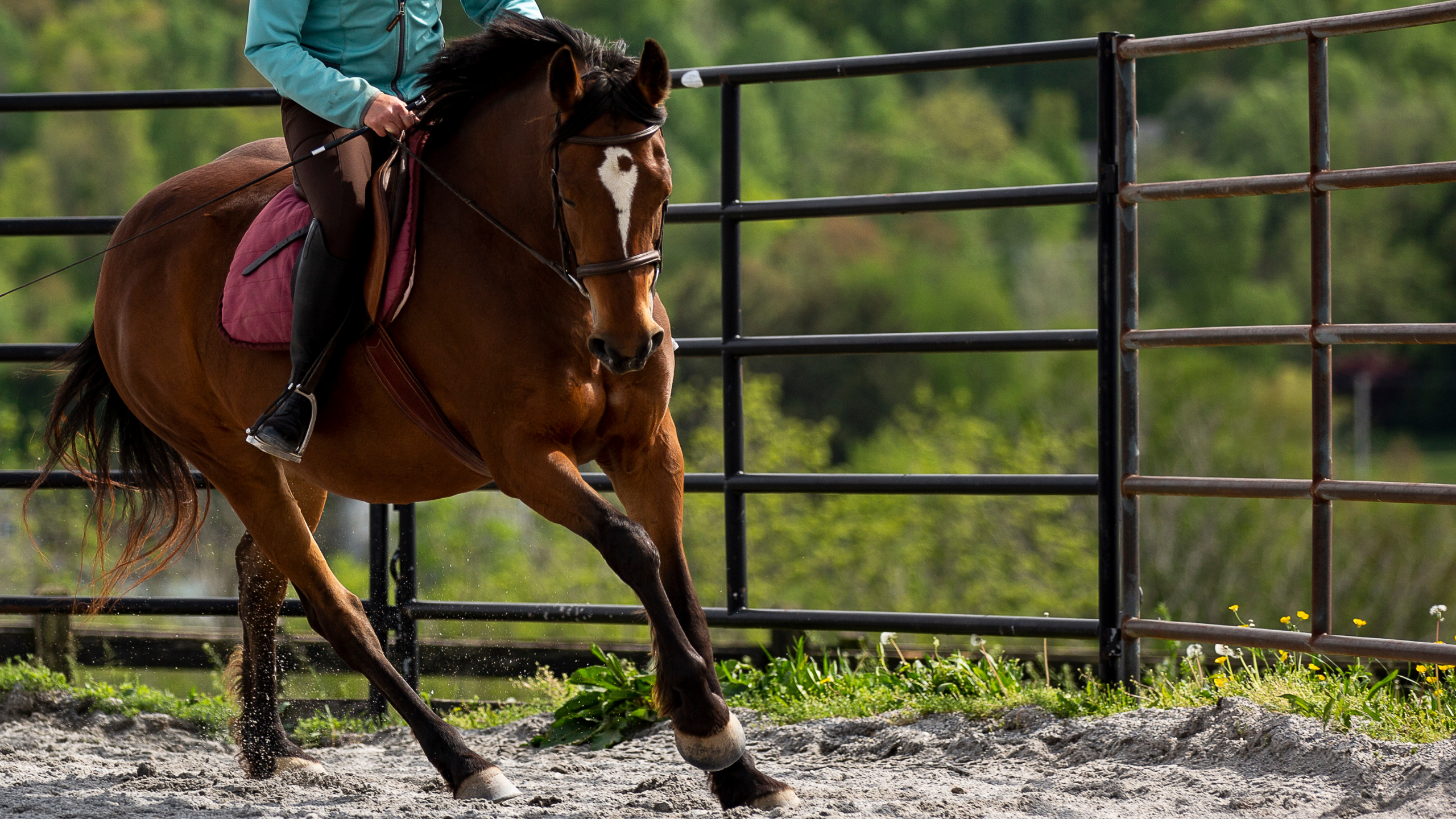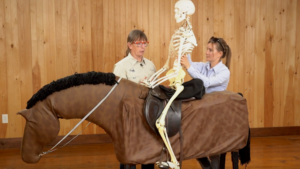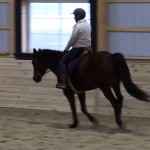If you have ever breathed a sigh of relief as your horse transitioned back to trot after a canter this video is for you.
When we do something that is more challenging or difficult (such as riding the canter, especially if it’s new), it is normal to feel a sense of relief when the main challenge has been accomplished.
You cantered! Maybe it was exhilarating, it was hard work, or it was even a bit scary. You tumble back into trot, concentration fading.
When we ride, we need to be present for every moment, continually aware of our and our horse’s balance and rhythm. When we stop riding, as so often happens in the transition from canter to trot, we can quickly lose that sense of balance and oneness with the horse.
At best, this makes for an uncomfortable transition where the horse is on the forehand and the rider gets bounced around.
At worst, the canter itself becomes more difficult to ride, as the horse develops bad habits of breaking to trot unexpectedly, veering to the inside of the arena, or just moving poorly.
In today’s video, I will show you several ways to improve your canter to trot transitions, so that you and your horse can remain in balance.














38 Responses
Nice explanation and demonstration in transitioning rom that to canter and back to a trot and walk. It’s nice to know that I’m doing it mostly correctly.
Nice explanation and demonstration on transitioning from trot to canter and back down to a trot and walk. It’s nice to know that I’m doing it mostly, correctly.
Great! Always good to get confirmation when we are on the right track 😉
Great class on transitioning from canter to trot! Can’t wait to put it to use! Thanks
Let me know how it goes April!
This came about at exactly the right time for me. I have been so frustrated at my downward transitions. I often felt that my horse was running through my hands when we transitioned the to trot. I am hoping that this will resolve a bad habit that I have developed (no it’s not biting my nails) of losing the energy from the canter to the trop and my horse collapsing in. Thank you so much for this.
Absolutely Sylvia! Thank you for watching!
Callie thank you so much for your video on the downward transition, truly it is the only one I have ever seen and I am sure it will be very useful 😊
Callie, you do remarkable training and instruction. I find all of your tips and videos super helpful. Thank you!
I have an icelandic so we will transition from canter to trot or canter to tolt. It’s amazing fun!!!
Keep up the great work!!@
I have never ridden an icelandic horse but their tolt looks like so much fun!
I love all your stuff and follow everything. I’ve read your book”stay in the saddle” word for
Word and found a great change for the better. My question is will you ever do Western? And gaited horses. I am 59 and alone. I do not know English and I have a nice big TNW and do not know how to move from gait to gait-any suggestions for me?
Thank you so much Denise! I do a lot of western riding and my start was with gaited horses 🙂 The foundations of riding are the same, english or western tack. While I can’t help you specifically with moving between the different gaits of a TNW horse, I do have this interview with Larry Whitesell that may be interesting: https://www.horseclass.com/blog/whats-different-about-gaited-horses/
Callie, Thanks so much for the video. As a relatively new rider who is only recently getting consistent with cantering, I absolutely do sometimes feel that sense of relief going down from trot to canter and sometimes fall forward in that downward transition. Yes, it is like I “stop riding” 🙂
I’ve heard you mention the rhythms before so will certainly try that and the posting to the trot. Thanks!
Let us know how it goes Adelle!
As Always a good video, I wish my Teacher explained things like you do, I find sometimes she(my teacher) teaches blindly and which leaves you in the dark.
I find that transitioning from trot to canter challenging mainly because the teacher does not give me the chance to ask for it but my horse seems to listen out for her rather than me. and before you know I am cantering without the preparation.
But the next time, (we are in lock down in Sydney, Aus) I will be 5 steps in front of my teacher)
Thanks again Callie
Hi Chris, an idea for better relating to your in person teacher… you could ask for him or her to help you feel things, for example, “could you put my leg in the position you are describing?” or “could you help me feel exactly how much tension I should have on the reins?” or “I would love to watch you demonstrate this so I understand it, when will you be riding that I could watch?”
This can help train your teacher to be more effective and help you get the understanding you need!
This was very helpful video for me. Downward transitions my horse’s back use to drop and he qets on his forehand. Thank you Callie 😊
Yes, this can often happen in down transitions, I hope these tips are helpful for you!
Thank you Callie. Your videos are always simple to follow and helpful.
Thanks Tressna! I so appreciate you being part of our community!
Thank you Callie, this was really excellent. I have focussed so much on the transition INTO canter that my transition to trot has always been rather chaotic (also because, as you mention, as a learner I am often so relieved to have cantered successfully that I just heave a huge sigh and bumble along!) Going to put this into practice the next time I am in the saddle.
Let me know how it goes Sarah!
Wonderful, thank you!
Glad you enjoyed this Robwyn!
Hi Callie,
Thanks for the video. I had a problem with one of the school horses which, when coming down from canter to trot, would start trotting very fast. I was not sure but I daresay it would have been my problem – but in any case it would make the rising trot not easy. I solved it in a particular way but I think it is perhaps not the best solution – I would kind of go into a slight two-point position where I would not be bouncing around and then slowly transition to rising trot. Is this OK?
Hi Sathya! Yes, this solution could work, however, be aware that you are not inadvertently taking your weight too far forward when you are in two-point. I would recommend rising the trot in the down transition to avoid the bouncing.
Thank you this is great to think about the rhythm especially at the transition. I appreciate your little video tips. It makes me think of more when I am riding.
I am so glad you enjoy these Marian!
Very eye-opening! Thank you! I’ll be trying to count the canter and then remember to count out the one-two one-two of the trot when I move into the downward transition — I’m a big fan of counting. An equally difficult task for me is actually getting the horse to halt from walk. I feel I am just now learning to rid with my seat in terms of steering, but halting from my seat (rather than pulling and pulling etc. with the reins) is still something I’ve not developed a feel for.
Thank you for bringing this up Pamela! Here is one way to think about this transition forward to walk. Imagine how you start walking on your own two feet. You shift your weight first. It is subtle and unconscious but there is always a weight shift before we start walking. This is the same concept in the saddle. Your weight shifts, and you may need to follow up with the aids of your legs or even a tap with a stick, but the weight shift is the first cue.
Lol! My transition from trot to canter with my 5 year old Haflinger has been an interesting journey. First he needed to understand that “hop-hop-buck-buck-buck” was not necessary first! Ground training to start and patience (lots of it). He is now realizing it’s a good thing to just transition straight from trot to canter! He has certainly not let me let my guard down during any transitions.
I definitely think it helps to keep the rhythm the gait you are transitioning to in your mindset as you ride. The horse will pick up on it.
haha! Yes, learning that jumping around before canter is not necessary is an important lesson for many horses!
Thank you Callie. I like how you flowed into a rising trot transitioning from canter to trot. And the reminder, feel for balance before you ask for a transition.
Glad this video was helpful for you Marjorie!
What would you suggest to help the rhythm of the canter flow, a sweep motion, a scoop motion in the hips?
I have two videos that may help Leah!
Here is the first one, a skeletal demo of riding canter: https://www.horseclass.com/blog/how-to-ride-the-canter-skeleton-demonstration/
and the second, specifically on riding the canter as a swing motion: https://www.horseclass.com/blog/riding-the-canter-its-a-swing-not-a-scoop/
Very thorough and understandable. I am learning from your videos everytime! Thank you, Callie!
Thank you so much for being here Bonnie!